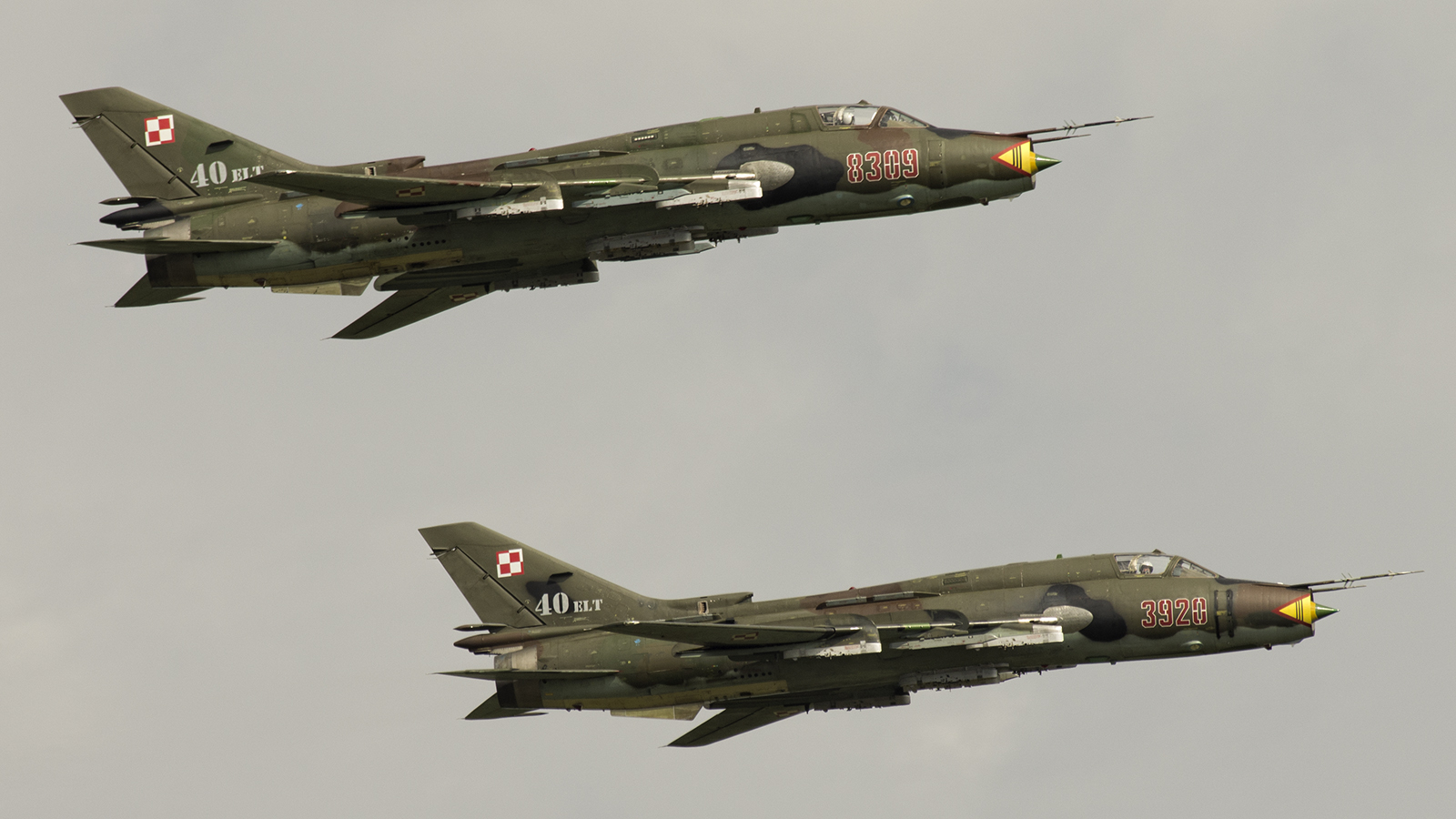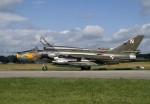
The Sukhoi Su-17 is a variable-sweep wing fighter-bomber developed for the Soviet military. Its NATO reporting name is “Fitter”. Developed from the Sukhoi Su-7, the Su-17 was the first variable-sweep wing aircraft to enter Soviet service. Two subsequent Sukhoi aircraft, the Su-20 and Su-22, have usually been regarded as variants of the Su-17.
- Su-20
- The initial export version of the Su-17M, (S-32MK).
- Su-22M5
- A Russian-French upgrade package offered for existing aircraft with modernized cockpit, HOTAS, improved avionic systems, and laser rangefinder replaced by Phazotron/Thomson-CSF radar.
- Su-22U
- The S-52U two-seat combat-trainer, export version of the Su-17UM, with a completely re-designed nose housing the tandem cockpits for student and instructor.
- Gun pods such as the GSh-23 based UPK-23 and SPPU-22 were utilized by the Su-17, Su-20, and Su-22. The SPPU-22 ground attack variant featured 30 degrees of traverse.
- An experimental version of the Su-20 was built with fixed wings attached to an Su-17M fuselage, in an effort to increase Payload/range performance by eliminating the weight of the wing sweep system. Good results were obtained in flight tests in 1973 but further development was cancelled.
- Tactical Reconnaissance versions of all variants could be made by fitting the KKR (Kombinirovannyi Konteiner Razvedky – combined reconnaissance pod) on the centre-line hardpoint.
| Role | Fighter-bomber |
|---|---|
| National origin | Soviet Union |
| Manufacturer | Sukhoi |
| First flight | 2 August 1966 |
| Introduction | 1970 |
| Status | In limited service |
| Primary users | Soviet Air Forces (historical) Syrian Air Force Polish Air Force Peruvian Air Force |
| Produced | 1969–1990 |
| Number built | 2,867 |
| Developed from | Sukhoi Su-7 |
Specifications (Su-17M4)
General characteristics
- Crew: 1
- Length: 19.02 m (62 ft 5 in)
- Wingspan: 13.68 m (44 ft 11 in) wings spread
-
-
-
- 10.02 m (33 ft) wings swept
-
-
- Height: 5.12 m (16 ft 10 in)
- Wing area: 38.5 m2 (414 sq ft) wings spread
-
-
-
- 34.5 m2 (371 sq ft) wings swept
-
-
- Airfoil: root: TsAGI SR-3S (5.9%); tip: TsAGI SR-3S (4.7%)
- Empty weight: 12,160 kg (26,808 lb)
- Gross weight: 16,400 kg (36,156 lb)
- Max takeoff weight: 19,430 kg (42,836 lb)
- Fuel capacity: 3,770 kg (8,311 lb)
- Powerplant: 1 × Lyulka AL-21F-3 afterburning turbojet engine, 76.4 kN (17,200 lbf) thrust dry, 109.8 kN (24,700 lbf) with afterburner
Performance
- Maximum speed: 1,400 km/h (870 mph, 760 kn) / M1.13 at sea level
-
-
-
- 1,860 km/h (1,160 mph; 1,000 kn) at altitude
-
-
- Combat range: 1,150 km (710 mi, 620 nmi) hi-lo-hi attack with 2,000 kg (4,409 lb) warload
- Ferry range: 2,300 km (1,400 mi, 1,200 nmi)
- Service ceiling: 14,200 m (46,600 ft)
- g limits: +7
- Rate of climb: 230 m/s (45,000 ft/min)
- Wing loading: 443 kg/m2 (91 lb/sq ft)
- Thrust/weight: 0.68
Armament
- Guns:
- 2 × 30 mm Nudelman-Rikhter NR-30 autocannons (80 rounds per gun, 160 rounds total)
- UPK-23 or SPPU-22 gun pods for 2 × Gryazev-Shipunov GSh-23L autocannons
- Hardpoints: 12 hardpoints with a capacity of up to 4,000 kg (8,800 lb) of stores,with provisions to carry combinations of:
- Missiles:
- Air-to-air missiles:
- K-13
- R-60
- R-73
- Air-to-surface missiles:
- Kh-23 Grom
- Kh-25ML
- Kh-29L/T/D
- Anti-radiation missiles:
- Kh-58
- Kh-27PS
- Kh-28
- Air-to-air missiles:
- Bombs: drop bombs, laser-guided bombs, electro-optical bombs, napalm bombs, drag chute bombs and cluster bombs
- Missiles:
- Rockets: S-5, S-8 & S-13
Photos Rob Vogelaar and Marcel van Leeuwen














